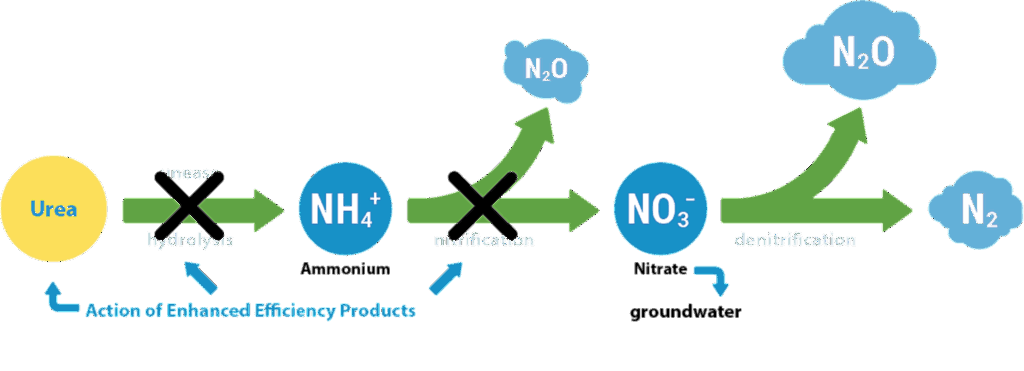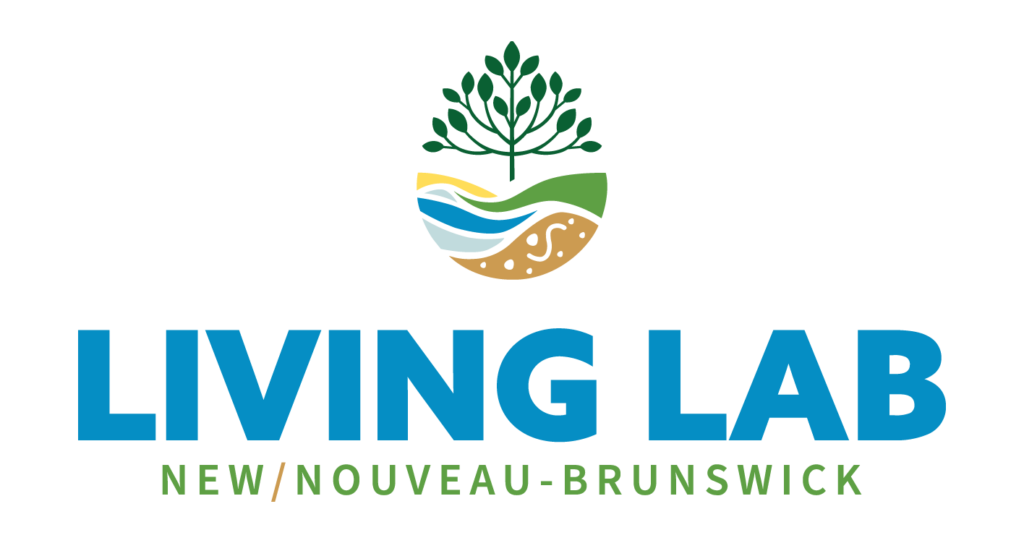Improving Nitrogen Management in Atlantic Canada
Using Enhanced Efficiency Nitrogen Fertilizers
David Burton, Dalhousie University
lkechukwu Agomoh, Agriculture and Agri-Food Canada
Faced with increasing nitrogen (N) fertilizer prices and calls from governments and the supply chain for reduced environmental impact of N use, producers are looking for means to increase the efficiency of N use while sustaining crop yields. Enhanced Efficiency Nitrogen Fertilizers (EENFs) represent a technological advancement aimed at increasing N use efficiency (NUE) and mitigating environmental impacts.

What are Enhanced Efficiency Nitrogen Fertilizers (EENFs)?
EENFs are formulations of N fertilizer designed to reduce N losses and improve the synchrony of N supply with plant N demand. They fall into two main categories:
Controlled-Release Fertilizers: Urea fertilizers can be encapsulated or coated to delay urea solubilization for seven to 10 weeks, depending on soil temperature and moisture conditions. These products require water to penetrate/dissolve the protective coating, releasing the urea. In periods of extended dry conditions, this may delay N availability beyond the period of maximum plant N demand.
Stabilized Fertilizers: Include inhibitors that slow down the conversion of urea or ammonium (NH4+) to nitrate (N03-). Nitrate is the primary form of N taken up by plants, but is also the form most susceptible to loss. There are several stabilizers that are commonly used. NBPT (N-(n -butyl) thiophosphoric triamide) is a urease inhibitor that slows the rate of urea hydrolysis to NH4+ and decreases ammonia (NH3) volatilization. NBPT is used with urea granules, mixed with liquid urea-based fertilizers, such as urea ammonium nitrate (UAN). Urease inhibitors are effective in delaying the hydrolysis of urea for one to two weeks and are frequently used to reduce NH3 loss from surface applied urea fertilizers. By delaying the production of NH4+, they also delay its nitrification and therefore the appearance of N03-. DCD (Dicyandiamide) and DMPP (3,4-dimethylpyrazole phosphate) are nitrification inhibitors that slow the conversion of NH4+ to N03– by four to 10 weeks, depending on soil conditions such as pH and soil temperature. Nitrification inhibitors are used with NH4+ – based fertilizers or fertilizers that generate ammonium such as urea.

Benefits of EENFs in Atlantic Canada
Surface Application: Producers often surface apply urea or UAN without subsequent incorporation. If not immediately incorporated or dissolved in rainwater, there is a high potential for NH3 loss. The use of a urease inhibitor can delay the formation of NH4+ until the urea is dissolved and washed into the soil and thereby reduce NH3 loss.
Reduced In-Season N losses: Atlantic Canada’s sub-humid climate and the predominance of coarse-textured soils results in a high potential for N03– loss. Wet periods during the growing season can result in significant loss of N03— either as a result of denitrification or leaching. The use of EENFs provides the opportunity to align the availability of added N fertilizer more precisely with plant N demand, resulting in reduced potential for early season N losses and increased efficiency.
Non-growing Season N Losses: Following harvest any N03– remaining in the soil is likely to be lost before the next growing season. The use of EENFs allows the use of reduced rates of N fertilizer while sustaining yield and therefore can result in reduced N03– remaining in the soil in the fall after harvest. Used improperly however, EENFs can increase the potential non-growing season loss as N released too late for the crop to effectively take it up and more N03– remains in the soil after harvest.
Application Strategies for Atlantic Canada
Make sure you are using the EENF with the right N source. Urease inhibitors are only useful if your N source contains significant amounts of urea. Nitrification inhibitors are only effective on ammonium-based N sources or sources that produce ammonium like urea. It is important when an EENF product is applied. The use of a urease inhibitor delays ammonium formation by one to two weeks, the use of a nitrification inhibitor delays nitrification by four to 10 weeks. Applied EENFs at, or just before, planting allows the formation of nitrate to occur closer to the period of rapid plant N uptake six to eight weeks after planting for most crops grown in Atlantic Canada. The use of an EENF achieves much the same result as split application, delaying the accumulation of N03– in the soil until a time closer to the period of increased plant N uptake. Using a nitrification inhibitor in an in-crop split application of N fertilizer is generally not recommended.
The use of a more efficient fertilizer source also provides the opportunity to reduce the amount of N fertilizer added without impacting yield, offsetting the increased cost of these products. Reducing N fertilizer rates also decreases the potential for high N03– levels in the soil following harvest and thus reduces the potential for overwinter N losses.
Should All my N Fertilizer be an Enhanced Efficiency Product?
No. Not all of your N fertilizer needs to be an EENF. Unprotected N sources can provide some of the N early in the season while the EENF will provide N during the period of maximum plant demand.
Can I Reduce my N Fertilizer Rate if using an Enhanced Efficiency Product?
Yes. Since the EENFs reduce N losses and supply N more efficiently to the crop, they can be applied at a reduced rate without compromising yield. An EENF will only increase yield if you were not applying sufficient N in the past. Since EENFs supply N 25 to 30 per cent more efficiently than conventional N fertilizers, the rate of application can be safely reduced by 15 to 20 per cent to achieve the same yield. This also allows the increased cost of the EENF to be offset by the reduced rate of application. Using EENF at a reduced rate also further reduces the environmental impact of N use and can reduce N20 emissions by as much as 50 per cent.
Conclusion
EENFs offer a promising solution to the dual challenges of maintaining agricultural productivity and protecting the environment in Atlantic Canada. By adopting EENFs within an integrated nutrient management framework, producers can improve nitrogen use efficiency, reduce their N fertilizer costs, reduce the environmental impact of N fertilizer use and contribute to a more sustainable agricultural future.
Key Messages
Enhanced Efficiency Nitrogen Fertilizers (EENFs) result in more efficient N use and not necessarily an increase in yield.
Choosing the right EENF and applying at the correct time better synchronizes N availability with plant N demand.
Because they are more efficient, EENFs can be applied at 15 to 20 per cent lower N rates without impacting yield.
Applied at a 15 to 20 per cent lower N rate, an EENF can both reduce the cost of your N fertilizer program as well reduce its environmental impact.

Living Lab New Brunswick uses a unique approach to agricultural innovation in Canada, bringing together farmers, scientists and other partners to co-develop and test innovative farming practices in real-world conditions. It is part of a nationwide network of living labs under the Agricultural Climate Solutions – Living Labs program, funded and supported by Agriculture and Agri-Food Canada. Each project aims to accelerate the development and adoption of sustainable on-farm solutions to address climate change.
